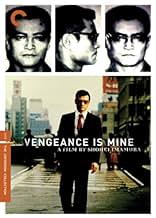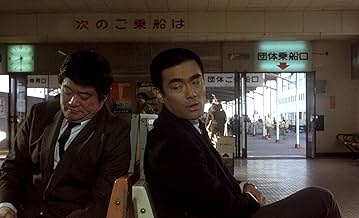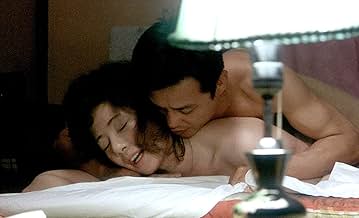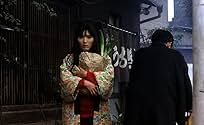AVALIAÇÃO DA IMDb
7,7/10
7,7 mil
SUA AVALIAÇÃO
Adicionar um enredo no seu idiomaChronological exploits of Iwao Enokizu, a murderous thief on the run.Chronological exploits of Iwao Enokizu, a murderous thief on the run.Chronological exploits of Iwao Enokizu, a murderous thief on the run.
- Direção
- Roteiristas
- Artistas
- Prêmios
- 21 vitórias e 6 indicações no total
- Direção
- Roteiristas
- Elenco e equipe completos
- Produção, bilheteria e muito mais no IMDbPro
Avaliações em destaque
Vengeance is Mine (1979) is a truly powerful film; an elliptical reconstruction/personal examination into the criminal mind, presenting a number of potential questions as to why this character became the person that he did, but offering us nothing in the way of easy answers. It is anchored by the central performance of Ken Ogata as Iwao Enokizu, a thirty-something tearaway and con artist who one day murders two men, seemingly for financial benefit, and in the process, triggers one of the largest and most infamous manhunts in Japanese history. Whereas the story presents numerous avenues of thought and situations that recall the very best of Hollywood serial killer films, crime fiction or the cinema of investigation, the film refuses to conform to any of this; giving us a juxtaposing mood wherein elements of documentary-like realism are cross-cut with a more enigmatic element of self-reflection, memory and examination.
Given this particular presentation, Vengeance is Mine can be seen as something of a difficult film; employing a fractured timeline that takes in thirty years of Iwao's family history, as well as offering us a central narrative perspective that seems to have been woven together from a number of different, highly conflicting viewpoints. Illustrating this device, director Imamura begins the film with the capture of Iwao and his transportation back to police HQ. From here, we cut to the police inspectors interrogating the murderer, who taunts them with his flippant behaviour, uncooperative attitude and provocative questioning before a chain of events begins to form. Here, Imamura juggles the narrative perspective of Iwao with that of the police, so that we are never quite sure if what we're seeing is a recreation of police evidence or the word of a man that we cannot really trust. As the film progresses, other characters will be introduced, and all of them will in some way contribute towards fleshing out the story in such a way that continues this idea of a patchwork narrative, or conversely, what film critic Tony Rayns refers to as "the lines of thought".
The effect that Imamura's structure has on us is at times staggering; cutting to a scene of spiralling family turmoil in between moments of murder and seduction, in a way that both disarms and distracts us; forcing us to ask questions and connect the dots as it were to try and pin point Iwao's exact reason for this misanthropic violence and rage. Later in the film, more surreal and enigmatic moments will be added to offer further shades of reference, accumulating as we crawl closer and closer to a final that we hope will tie these issues together, but instead, leaves us with even more questions pertaining to the complex ideas regarding love, honour, family, faith, society, spirituality, regret, rage, murder, life and death. This presents a stark irony to the film. Whereas the structure of the script and the presentation of the characters and narrative are incredibly complicated and vague, Imamura's direction is subtle and as light as a feather.
Perhaps drawing somewhat on his past work in documentary-directing, the style of Vengeance is Mine has an uncomplicated minimalism and sense of urgency. Imamura makes great use of cramped, claustrophobic interiors, from the police car in the opening sequence, to the interrogation scenes, to the sequences between Iwao and the owner of a hotel where he later hides out. He also captures the spirit of 60's Japan, moving from the small islands and villages with their old ways and traditional values, to the bright lights of the city and a beguiling underworld of crime and prostitution. Much of the film is shot in a very light, cinéma-vérité style with hand-held cameras or locked off shots framed through windows and doorways, with the use of extensive on-screen inter-titles to announce the names of victims, the date and times of death, and the choice of murder weapon. Again, this appropriation of style and the emphasis on examination and a certain presentation of reality in all its sordid detail is very much keeping with Imamura's previous documentary work, and the lurid, real-life aspect of Iwao Enokizu's unprovoked double-murder, and the gruelling 78 day manhunt that followed.
In keeping with this uncomplicated visual approach, the violence of Vengeance is Mine is stark, uncompromising and brutal. As ferocious and provocative as the central performance from Ken Ogata and as cold and unsympathetic as the murders in Kieslowski's A Short Film About Killing (1988). Given Iwao's character, and Imamura' refusal to take sides regarding these complicated issues - presenting the drama from a distance and allowing the audience the opportunity to make up their own mind regarding the various rights and wrongs - Vengeance is Mine will definitely be a difficult work for many viewers. Iwao is such an unlikable and unsympathetic character and yet, we watch the film unfold through his eyes and share in his thoughts, feelings, lies and disappointments. The title is also misleading and vague; tapping into the ideas of Catholicism central to the plot but in no way representing the view point of any of these characters.
Ultimately, Vengeance is Mine requires thought and consideration on the part of the audience to pick apart the various sub textual ideas presented by the narrative and the matter of fact way in which the direction comments on them. There are clear ideas of family, with the relationship between husband and wife, father and son, mother and son all driving Iwao to commit these crimes and show no sympathy, as well as cultural and spiritual taboos central to the Japanese culture of the post war era. The highly enigmatic ending also adds further shades that require personal interpretation, with the last five minutes presenting something vaguely surreal and undoubtedly thought provoking. Vengeance is Mine is a bold and provocative work that forces the viewer to ask some serious questions, with no guarantee of any easy answers, and remains a powerful and uncompromising work of intelligent cinema.
Given this particular presentation, Vengeance is Mine can be seen as something of a difficult film; employing a fractured timeline that takes in thirty years of Iwao's family history, as well as offering us a central narrative perspective that seems to have been woven together from a number of different, highly conflicting viewpoints. Illustrating this device, director Imamura begins the film with the capture of Iwao and his transportation back to police HQ. From here, we cut to the police inspectors interrogating the murderer, who taunts them with his flippant behaviour, uncooperative attitude and provocative questioning before a chain of events begins to form. Here, Imamura juggles the narrative perspective of Iwao with that of the police, so that we are never quite sure if what we're seeing is a recreation of police evidence or the word of a man that we cannot really trust. As the film progresses, other characters will be introduced, and all of them will in some way contribute towards fleshing out the story in such a way that continues this idea of a patchwork narrative, or conversely, what film critic Tony Rayns refers to as "the lines of thought".
The effect that Imamura's structure has on us is at times staggering; cutting to a scene of spiralling family turmoil in between moments of murder and seduction, in a way that both disarms and distracts us; forcing us to ask questions and connect the dots as it were to try and pin point Iwao's exact reason for this misanthropic violence and rage. Later in the film, more surreal and enigmatic moments will be added to offer further shades of reference, accumulating as we crawl closer and closer to a final that we hope will tie these issues together, but instead, leaves us with even more questions pertaining to the complex ideas regarding love, honour, family, faith, society, spirituality, regret, rage, murder, life and death. This presents a stark irony to the film. Whereas the structure of the script and the presentation of the characters and narrative are incredibly complicated and vague, Imamura's direction is subtle and as light as a feather.
Perhaps drawing somewhat on his past work in documentary-directing, the style of Vengeance is Mine has an uncomplicated minimalism and sense of urgency. Imamura makes great use of cramped, claustrophobic interiors, from the police car in the opening sequence, to the interrogation scenes, to the sequences between Iwao and the owner of a hotel where he later hides out. He also captures the spirit of 60's Japan, moving from the small islands and villages with their old ways and traditional values, to the bright lights of the city and a beguiling underworld of crime and prostitution. Much of the film is shot in a very light, cinéma-vérité style with hand-held cameras or locked off shots framed through windows and doorways, with the use of extensive on-screen inter-titles to announce the names of victims, the date and times of death, and the choice of murder weapon. Again, this appropriation of style and the emphasis on examination and a certain presentation of reality in all its sordid detail is very much keeping with Imamura's previous documentary work, and the lurid, real-life aspect of Iwao Enokizu's unprovoked double-murder, and the gruelling 78 day manhunt that followed.
In keeping with this uncomplicated visual approach, the violence of Vengeance is Mine is stark, uncompromising and brutal. As ferocious and provocative as the central performance from Ken Ogata and as cold and unsympathetic as the murders in Kieslowski's A Short Film About Killing (1988). Given Iwao's character, and Imamura' refusal to take sides regarding these complicated issues - presenting the drama from a distance and allowing the audience the opportunity to make up their own mind regarding the various rights and wrongs - Vengeance is Mine will definitely be a difficult work for many viewers. Iwao is such an unlikable and unsympathetic character and yet, we watch the film unfold through his eyes and share in his thoughts, feelings, lies and disappointments. The title is also misleading and vague; tapping into the ideas of Catholicism central to the plot but in no way representing the view point of any of these characters.
Ultimately, Vengeance is Mine requires thought and consideration on the part of the audience to pick apart the various sub textual ideas presented by the narrative and the matter of fact way in which the direction comments on them. There are clear ideas of family, with the relationship between husband and wife, father and son, mother and son all driving Iwao to commit these crimes and show no sympathy, as well as cultural and spiritual taboos central to the Japanese culture of the post war era. The highly enigmatic ending also adds further shades that require personal interpretation, with the last five minutes presenting something vaguely surreal and undoubtedly thought provoking. Vengeance is Mine is a bold and provocative work that forces the viewer to ask some serious questions, with no guarantee of any easy answers, and remains a powerful and uncompromising work of intelligent cinema.
This dark masterpiece pushes to the limits of my toleration for violence and sex. We get to watch the "how", "when", "where" of the story of the murderous sociopath (brilliantly portrayed by Ken Ogata) but are denied any convincing "why" by Imamura. This film seemed to have echoes of Poe -- another master at combining humor with the horrific and macabre. When it comes to cinema, though, there is no other master anything like Imamura.
No aspect of this film (acting, cinematography, script) is less than impressive. A recent 2 DVD set from Panorama (a Hong Kong company) provides English subtitles and is technically adequate (albeit far from superlative).
No aspect of this film (acting, cinematography, script) is less than impressive. A recent 2 DVD set from Panorama (a Hong Kong company) provides English subtitles and is technically adequate (albeit far from superlative).
I think this movie is an all around tour-de-force depiction of a sociopath. All aspects of this movie are superb. The main actor gives a truly chilling and convincing portrayal of a man with no conscience, at the same time giving his character great depth and complexity. Aside from being based on true events, this cold blooded murderer is much more realistic than the clever game-playing types portrayed in such films as "Silence of the Lambs". I would highly recommend this movie to all but the squeamish.
Far from a film that explores the "whydunit?" of a ruthless but charming murderer, Vengeance of Mine bristles with all the energies Imamura believes the real Japanese possess. These people are in lower social positions and just trying to survive the brutality of day-to-day struggles. In their energy, courage, and perseverance to survive, Vengeance of Mine becomes beautiful and captivating to watch.
Admittedly, it is quite difficult to understand such stereotypes as murderer, tempted Catholic, prostitute, pimp/hotel owners, and delivery men as eccentric individuals in the space of two hours. But oddly enough, I feel a strange sense of familiarity in the hustle and bustle of these characters in the story. They may live their lives teetering on what is considered socially acceptable or healthful, but Imamura presents them with such respect and curiosity (of an anthropologist?!) - that I cannot resist feeling their robust lives leaping off the screen. In this way their seemingly bizzare and extreme behavior are very convincing, very real, and very touching.
Highly recommended for the challenging story (flashbacks, vignettes, illogical twists and turns of story and visual), quirky pace, idyllic country scenes, and the wonderful performance of Ken Ogata.
Admittedly, it is quite difficult to understand such stereotypes as murderer, tempted Catholic, prostitute, pimp/hotel owners, and delivery men as eccentric individuals in the space of two hours. But oddly enough, I feel a strange sense of familiarity in the hustle and bustle of these characters in the story. They may live their lives teetering on what is considered socially acceptable or healthful, but Imamura presents them with such respect and curiosity (of an anthropologist?!) - that I cannot resist feeling their robust lives leaping off the screen. In this way their seemingly bizzare and extreme behavior are very convincing, very real, and very touching.
Highly recommended for the challenging story (flashbacks, vignettes, illogical twists and turns of story and visual), quirky pace, idyllic country scenes, and the wonderful performance of Ken Ogata.
Immamura Shohei, one of Japan's best directors, does not put a foot wrong in VENGEANCE IS MINE, one of the best films ever made.
This is a searing, raw, uncompromising study of a disturbed, callous, opportunistic killer, husband and son.
The film, running just over two hours, takes an almost doco-style approach to the crimes of its protagonist (played with chilling conviction by Ken Ogata) and takes great pains to examine the impact his behavior had on his mother, father and wife.
A flashback, which goes some way towards explaining how Ogata developed such a disdain for authority, is a masterstroke of cinematic brevity.
Although Immamura is known mostly for such brilliant work as THE PORNOGRAPHERS, BLACK RAIN and the excellent THE EEL, this is surely his crowning achievement, a film so rich and involving that it personifies everything that is so amazing about Japanese cinema, truly a cinema of the soul.
This is a searing, raw, uncompromising study of a disturbed, callous, opportunistic killer, husband and son.
The film, running just over two hours, takes an almost doco-style approach to the crimes of its protagonist (played with chilling conviction by Ken Ogata) and takes great pains to examine the impact his behavior had on his mother, father and wife.
A flashback, which goes some way towards explaining how Ogata developed such a disdain for authority, is a masterstroke of cinematic brevity.
Although Immamura is known mostly for such brilliant work as THE PORNOGRAPHERS, BLACK RAIN and the excellent THE EEL, this is surely his crowning achievement, a film so rich and involving that it personifies everything that is so amazing about Japanese cinema, truly a cinema of the soul.
Você sabia?
- CuriosidadesBased on true story of serial killer Akira Nishiguchi.
- Erros de gravaçãoFlashback scene taking place in 1946 features an American flag containing 50 stars on the back of a US Army Jeep. The US flag in 1946 featured only 48 stars in even rows and columns of six.
- Citações
Shizuo Enokizu: You can only kill those who never harmed you.
- ConexõesFeatures Libertação 3 - A Direção do Ataque Principal (1971)
Principais escolhas
Faça login para avaliar e ver a lista de recomendações personalizadas
- How long is Vengeance Is Mine?Fornecido pela Alexa
Detalhes
- Data de lançamento
- País de origem
- Central de atendimento oficial
- Idiomas
- Também conhecido como
- Vengeance Is Mine
- Locações de filme
- Kannawa Hot Spring, Beppu, Oita, Japão(Murder Scene)
- Empresas de produção
- Consulte mais créditos da empresa na IMDbPro
Bilheteria
- Faturamento bruto nos EUA e Canadá
- US$ 11.891
- Faturamento bruto mundial
- US$ 21.452
Contribua para esta página
Sugerir uma alteração ou adicionar conteúdo ausente



























